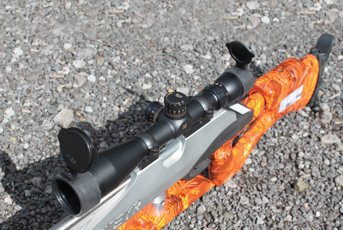Sightron SIII for HFT
-
0
 Comments
Comments
- Last updated: 15/12/2016

In the sport of Hunter Field Target the versatility of a variable mag scope just isn’t required. However, an accurately reproduced Mil-Dot reticule is pretty well essential for most competitors.
A Mildot Too Far
There’s a bit of a back story to this scope review, as I first saw and tested a preproduction model over eighteen months ago. I know the UK importer very well and they asked me to take a look at what was going to be one of Sightron’s new scopes. When I looked at the specifications of this scope it just screamed out “Perfect Hunter Field Target scope”. It is the magic fixed ten times magnification, it has parallax adjustment (I know you cannot P/A in a comp but for setting up a HFT scope you really need P/A), it has a 30mm body tube, it has target turrets and a 42mm objective lens. Coupled with an optical quality not seen on any other scope it its price range, it got me very, very excited.
It also had a Mildot reticle with half Mil dashed lines between the Mildots. However, the HFT world and Aim Field Sports - the UK importer for the scope - were both gutted when I tested the Mildot spacing to find it was 1.25 Mildots and therefore not a true Mildot.
Sightron listened to Aim Field Sports and to help things along I even sent over to the USA the measuring reference charts I had used to check the pre-production scope. Such were the timescales and the huge American market (both hunting and target) clamouring out for the scope that Sightron were compelled to release the scope as it was.
Aim sold a few over here but being the brilliant firm they are, they did not hoodwink the public (as some others might do), instead they told buyers that the reticule was not - as yet – a true Mildot. I say yet as Sightron was in contact with myself and Aim to try and solve the problem.
Why is true Mildot so important to HFT? Well for the trajectory of a .177 calibre pellet and the bracketing range finding on 15mm, 25mm and 40mm hit zone sizes a true Mildot is ideal. There are even aiming and bracketing charts available online which newbie’s to HFT can download to take a lot of the hard work out of learning rangefinding and where to aim.
True Mil
Well the wait is now over and the Sightron 10*42MMD now has a true Mildot reticle. It’s a modified Mildot in that in between the Mil-dots there are small lines mid-way to each dot to make half Mildot reference marks. The original pre-production reticle had pointed tops to the change in section at five Mildot’s off the center, the new true Mildot reticle has a flat square top to that area, the same as my own Schmidt and Bender HFT scope. When checking distances I used a surveyor’s tape measure (not a laser rangefinder or pacing it out!) and two Mildot charts to check the scope at 15, 25 and 45 yards and the Mildot spacing’s are bang on.
Build Quality
Getting to the construction of the scope; it has a 30mm one piece body tube made of aircraft grade aluminium, which is twice as thick as the bodies on Sightron’s 25mm scopes. This really is a tough scope. It’s actually made for tactical centerfire guns in the US, and is fogproof, shockproof and waterproof. The glass is the real heart of any scope and on the Sightron the modified Mil-dot reticle is etched onto some top end lenses. They are treated with seven coatings and when you look through a Sightron you know what quality glass it is. It even comes with flip up scope covers to protect those excellent lenses.
The parallax adjustment (P/A) system on the scope is unique in that is sits on the eye-bell where you would normally see a zoom ring on a variable magnification scope. It adjusts from 10 yards to infinity, and while I was setting the scope to 20m (23 yards) which I use for HFT, I noticed that the P/A is very sensitive. That’s a good thing in my book and actually a bonus for HFT shooters who use the out of focus image to rangefind when the P/A is not correct for the target they are looking at.
The target style turrets have ¼ MOA clicks, which means you can very precisely zero your gun, again vital for HFT where the target kill zones come down to a mind numbing 15mm in diameter. The Sightron has their Exactrac system where the adjustment screws touch the scope body, it was made for bench rest shooting to remove the zero jump seen with conventional scope systems so it’s more than good enough for HFT.
Not Just HFT
The Sightron SIII 10*42MMD has a very good all-around specification, for full-bore tactical, rimfire and airgun hunting but it becomes the king when used for HFT. It has found its way onto my own Steyr LG-110 HFT rifle in place of a custom made Schmidt and Bender - make of that what you will.
Pete Sparkes recently won the Anglo American Extreme HFT shoot (which had 8 and 10mm discs) with his Sightron! So it’s already a winning scope, and I’m sure that’s just the first of many.
PRICE: £570
